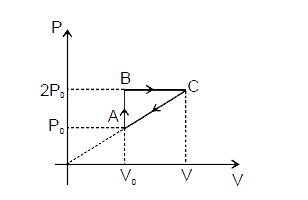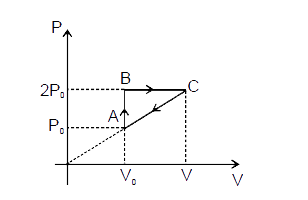n moles of a diatomic gas has undergone a cyclic process ABC as shown in figure. Temperature at a is . Find
a. Volume at C ?
b. Maximum temperature ?
c. Total heat given to gas ?
d. Is heat rejected by the gas, if yes how much heat is rejected ?
e. Find out the efficiency
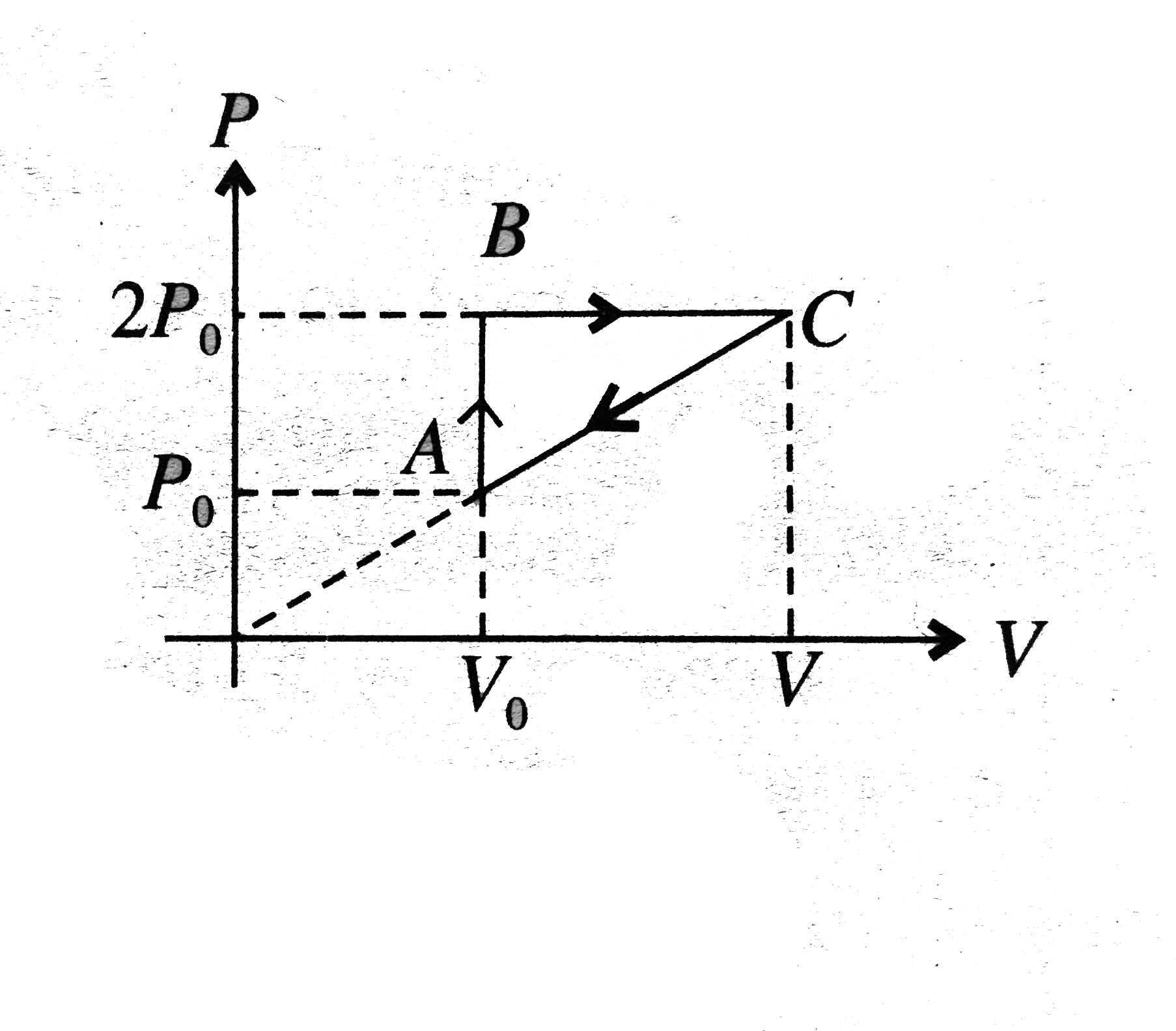
Since triangle and OC V are similar therefore
b. Since process AB is isochoric hence
Since process BC is isobaric therefore
Since process is cyclic therefore
= area under the cycle .
d. Since and both are negative in process CA
is negative in process ca and heat is rejected in process CA
Heat injected.
e. efficiency of the cycle
Topper's Solved these Questions
- KINETIC THEORY OF GASES AND FIRST LAW OF THERMODYNAMICSBOOK - CENGAGE PHYSICSCHAPTER - KINETIC THEORY OF GASES AND FIRST LAW OF THERMODYNAMICSEXERCISE - Solved Examples
14 Videos
- KINETIC THEORY OF GASES AND FIRST LAW OF THERMODYNAMICSBOOK - CENGAGE PHYSICSCHAPTER - KINETIC THEORY OF GASES AND FIRST LAW OF THERMODYNAMICSEXERCISE - Exercise 2.1
20 Videos
- KINETIC THEORY OF GASESBOOK - CENGAGE PHYSICSCHAPTER - KINETIC THEORY OF GASESEXERCISE - Compression
2 Videos
- LINEAR AND ANGULAR SIMPLE HARMONIC MOTIONBOOK - CENGAGE PHYSICSCHAPTER - LINEAR AND ANGULAR SIMPLE HARMONIC MOTIONEXERCISE - Multiple Correct Answer Type
9 Videos
Similar Questions
Knowledge Check
n' moles of an ideal gas undergoes a process A→B as shown in the figure. The maximum temperature of the gas during the process will be:
 A9P0V02nRB9P0V0nRC9P0V04nRD3P0V02nR
A9P0V02nRB9P0V0nRC9P0V04nRD3P0V02nROne mole of a diatomic ideal gas undergoes a cyclic process ABC as shown in figure. The process BC is adiabatic. The temperature at A,B and C are 400K, 800K and 600K respectively. Choose the correct statement:
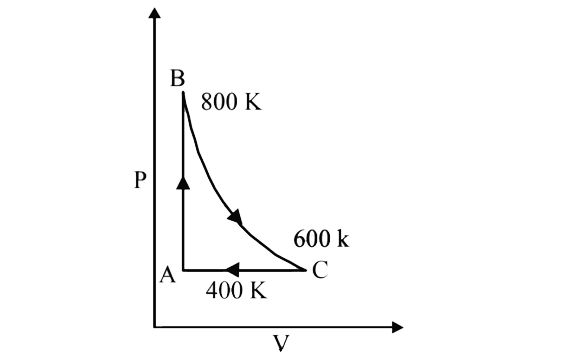 AThe change in internal energy in whole cyclic process is 250R.BThe change in internal process CA is 700R.CThe change in internal energy in the process AB is -350R.DThe chang in internal energy in the process BC is -500R.
AThe change in internal energy in whole cyclic process is 250R.BThe change in internal process CA is 700R.CThe change in internal energy in the process AB is -350R.DThe chang in internal energy in the process BC is -500R.Two moles of helium gas undergo a cyclic process as shown in figure. Assuming gas to be ideal, the net heat exchange in the process will be
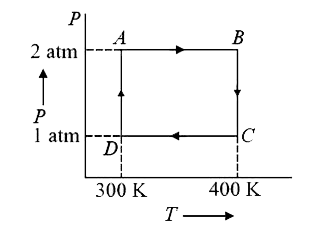 A1000 JB1152 JC1200 JD1500 J
A1000 JB1152 JC1200 JD1500 J
n moles of a diatomic gas has undergone a cyclic process ABC as shown in figure. Temperature at A is T0. Find
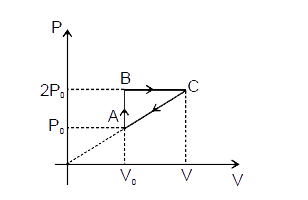 Total heat given to gas ?
Total heat given to gas ?
View Solutionn moles of a diatomic gas has undergone a cyclic process ABC as shown in figure. Temperature at A is T0. Find
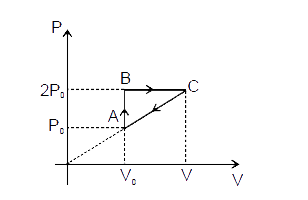
Find out the efficiency
View Solutionn moles of a diatomic gas has undergone a cyclic process ABC as shown in figure. Temperature at A is T0. Find
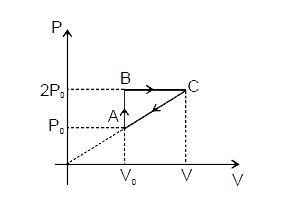 is heat rejected by the gas, if yes how much heat is rrejected ?
is heat rejected by the gas, if yes how much heat is rrejected ?
View SolutionOne mole of an ideal monatomic gas is taken round the cyclic process ABCA as shown in figure. Calculate
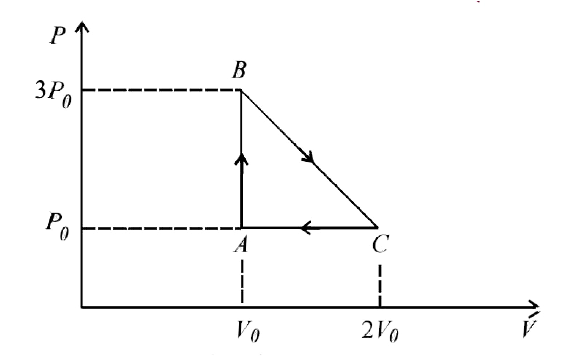
(a) the work done by the gas.
(b) the heat rejected by the gas in the path CA and the heat absorbed by the gas in the path AB,
(c) the net heat absorbed by the gas in the path BC,
(d) the maximum temperature attained by the gas during the cycle.
View SolutionOne mole of an ideal monoatomic gas undergoes a cyclic process, as shown in the figure. If the temperature of the gas at state 1 is 300 K and at state 4 is 500 K, then heat exchanged during process 2→3, is
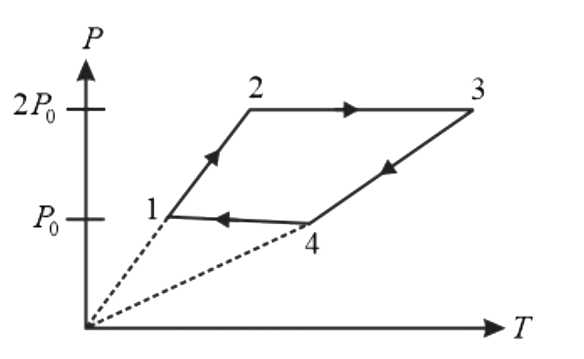
View Solution

